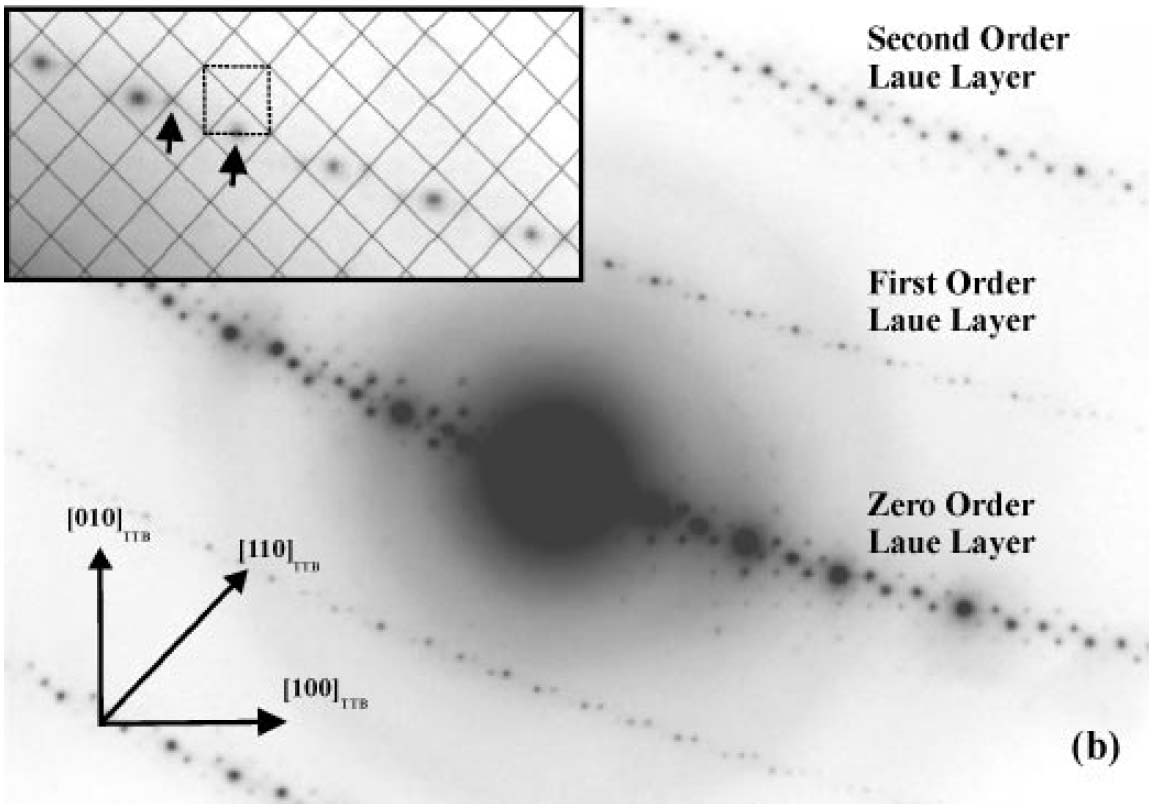=================================================================================
√2-TTB phase of PbxNb1.17W1.0O5.93+x (x > 0.15) in Figure 2324 presented asymmetric electron diffraction patterns and exhibited systematically weak odd-order (First order here) Laue layers lying half-way between the positions of the strong even-order (zero and second order here) layers. The even-order layers correspond to the basic 3.8 Å cTTB (c axis of TTB structure) repeat. Analyses of multiple samples indicate that these weak odd-order reflections were present in the same positions as the maxima in the even layers and at the midpoint of each edge of the basic TTB square.

Figure 2324. Asymmetric diffraction pattern of the √2-TTB phase of PbxNb1.17W1.0O5.93+x (x > 0.15). The inset enlargement of the first-order Laue layer shows that the black mesh defines the √2-TTB reciprocal lattice periodicity [2], and the dashed square illustrates the position of the basic TTB cell repeat with respect to the √2-TTB cell.
Adapted from [1]
The asymmetric diffraction pattern can be explained by the basis of structure factor. For instance, the statistical structure factor of the PbxNb1.17W1.0O5.93+x materials can be expressed by the contributions from the cation and oxygen atom frameworks: F(hkl) = FM(hkl) + FO(hkl). Their supercell contains four equivalent (MO)2M20 units of the o-√2TTB structure at (0, 0, 0), (1/2, 1/2, 0), (0, 0, 1/2), and (1/2, 1/2, 1/2) [1], therefore, the overall structure factor from the framework cations can be assumed by,
 ------------- [2324a] ------------- [2324a]
where,
NM -- The number of Nb and W atoms
The reflections are absent unless l and h+k are even, therefore, cation scattering does not contribute to odd-order Laue layers (where l is odd). On even-order layers maxima are induced at the positions corresponding to the corners and center of the basic TTB cell.
On the other hand, the framework anions are located at the positions (0, 0, 0) (0, 1/2, 0), (1/2, 0, 1/2), and (1/2, 1/2, 1/2). Therefore, the structure factor from the framework anions can be assumed by,
 ------------- [2324b] ------------- [2324b]
where,
NO -- The number of oxygen atoms
Therefore, oxygen scattering contributes to both odd and even Laue layers. When l is even, both h and k must be even for maxima to be observed and thus only the basic TTB reflections occur. For the cases that l is odd, to observe the maxima lying half-way along one side of the TTB square in the even layer, k must be even and h odd.
The difference between Equations 2324a and 2324b determines the difference of the reflection intensities in the odd- and even-order Laue layers because oxygen gives weaker scattering while Nb and W atoms give stronger.
[1] Sarah K. Haydon and David A. Jefferson, Quaternary Lead-Niobium-Tungsten Oxides Based on the Tetragonal Tungsten Bronze Structure, Journal of Solid State Chemistry 161, 135 - 151 (2001).
[2] S. K. Haydon, Ph.D. Thesis, University of Cambridge, 2000.
|

 ------------- [2324a]
------------- [2324a]  ------------- [2324b]
------------- [2324b]